Top speed 412 km/h Cruise speed 412 km/h Weight 1,330 kg Engine type Turboprop | Range 2,630 km Wingspan 10 m Length 9.78 m | |
 | ||
The Pilatus PC-7 Turbo Trainer is a low-wing tandem-seat training aircraft, manufactured by Pilatus Aircraft of Switzerland. The aircraft is capable of all basic training functions including aerobatics, instrument, tactical and night flying. It has been selected by more than 20 air forces as their ab initio trainer. Since the aircraft's introduction in 1978, close to 500 have been sold, with the majority still in service. Over one million hours have been flown by PC-7s worldwide.
Contents
- Pilatus pc 7 fun over swiss alps
- Development
- Operational history
- Variants
- Military operators
- Former military operators
- Former civil operators
- Accidents and incidents
- Specifications PC 7 Turbo Trainer
- References

Pilatus pc 7 fun over swiss alps
Development
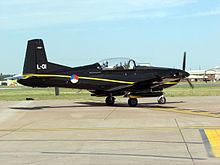
The PC-7 is based on the earlier piston-powered Pilatus P-3. The first prototype, modified from the prototype P-3 by replacing its Lycoming O-435 engine with a Pratt & Whitney PT6A-20 turboprop, flew on 12 April 1966, but after a crash the PC-7 programme was shelved.
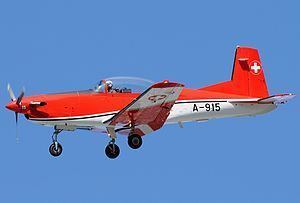
In 1973, the programme was restarted and another P-3 was obtained from the Swiss Air Force. After modification, this aircraft flew on 12 May 1975. Further extensive modifications followed later in the programme, including a new one-piece wing with integral fuel tanks, an altered tailfin and a bubble canopy.
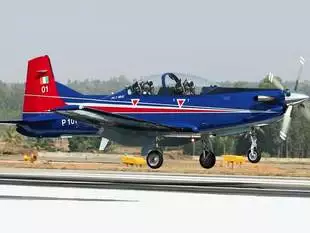
The first production aircraft flew on 12 August 1978. Swiss civil certification followed on 5 December of the same year, with deliveries, to Burma and Bolivia starting immediately thereafter.
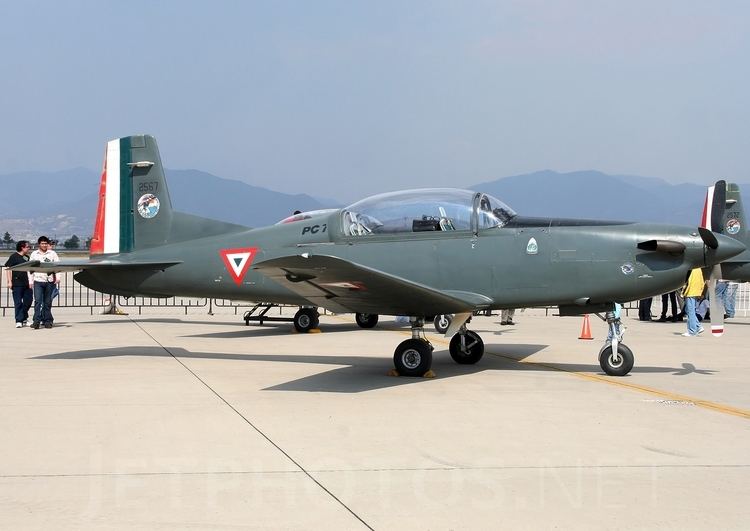
The aircraft is also used by private customers and is both FAA and FOCA civil certified to comply to the general aviation regulations in Europe and the USA.
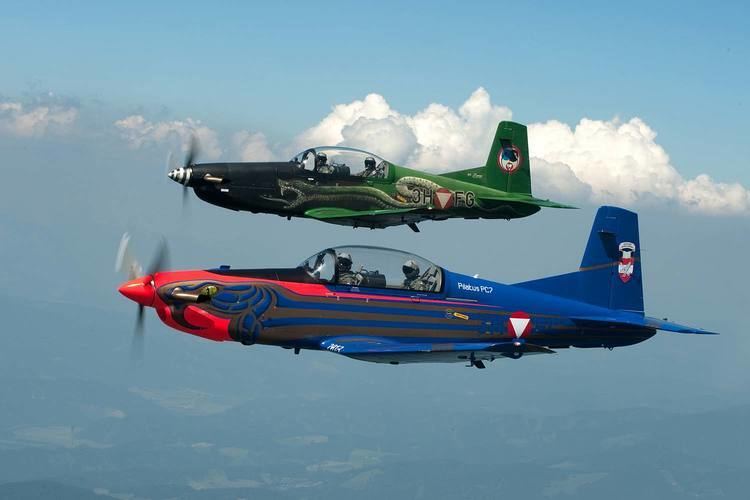
The PC-7 Mk II is a development of the PC-9's airframe and avionics, fitted with the PC-7's smaller turbine to lower operating and maintenance costs. It is used by the South African Air Force, with sixty examples having been manufactured. The aircraft were assembled in South Africa from kits supplied by Pilatus. The value of the contract was estimated to be 175 million USD in 1993. Due to political considerations, the aircraft were not fitted with the armament hardpoints. Four PC-7 Mk II aircraft are used by the air force of Brunei.
Operational history
PC-7s were used by the Iraqi Air Force for close air support in the Iran-Iraq war. They were also used to deliver chemical weapons against Iranian troops.
The Chadian Air Force has used its small fleet of PC-7s to bomb rebel positions both in their own territory and in neighbouring Sudan.
PC-7s were employed by the Guatemalan Air Force in air strikes and for close air support during the Guatemalan civil war, starting in 1982 until the end of the conflict in 1996. The PC-7s deployed from the airfield in La Aurora armed with gunpods and light rocket launchers.
In 1994, Mexican Air Force armed PC-7s were used to attack Zapatista Army of National Liberation during the Chiapas conflict in Mexico. This action was considered illegal by the Swiss government because the airplanes were sold for training purposes only, and as result, Switzerland issued a ban to sell more units to Mexico.
In the mid to late 1990s, Executive Outcomes, a private military contractor (PMC) led by Eben Barlow, utilised three armed PC-7s (ex-Bophuthatswana Air Force aircraft) to provide close air support during its operations in Sierra Leone.
In June 2011, the Indian Air Force selected the Pilatus PC-7 MkII trainer as its basic trainer, an initial order of 75 was made. This order could be progressively increased to 181 trainers after technology transfer to India. The Indian cabinet approved the deal to buy the trainer. The contract was signed on 24 May 2012. As of 20 March 2014 the Indian MOD requested additional information for another 175 aircraft.
Variants
Military operators
An incomplete list of the users of the PC-7:
Former military operators
Former civil operators
Accidents and incidents
The South African Air Force (SAAF) grounded their fleet of PC-7 MkIIs after a crash on 15 January 2008. The aircraft went down shortly after takeoff from Overberg Air Force Base in the Western Cape Province. SAAF Lieutenant-Colonel Chris Meiring, 58, died shortly after the crash. The aircraft was flying to Langebaanweg Air Force Base for maintenance but shortly after takeoff it rolled and flew into the ground. The cause is believed to have been a structural problem.
In November 2009, a civilian passenger in the back seat of a South African Air Force Pilatus PC-7 MK II ejected from the aircraft while in flight. The civilian accidentally pulled the yellow and black ejection lever while trying to brace himself. The passenger is thought to be a friend of the pilot, Captain Gerhard Lourens of the Silver Falcons. Civilians are not usually allowed in SAAF aircraft equipped with ejector seats. An air force spokesman confirmed that officials had launched an investigation into the accident. The passenger survived the incident.
In March 2010, a pilot was killed when his Royal Malaysian Air Force (RMAF) aircraft exploded and caught fire in midair during a solo airshow. This is the fifth accident involving Royal Malaysian Air Force PC-7 aircraft.
In June 2010, two Mexican pilots were killed when their Air Force PC-7 crashed after taking off from Pie de la Cuesta, a district in the resort city of Acapulco, Mexico. The PC-7 crashed into the sea near Acapulco.
On 20 October 2011, two PC-7s of the Botswana Defence Force were involved in a midair collision over Letlhakeng 100 km west of Gaborone. Two of the four aircrew involved were killed in the accident.
Specifications (PC-7 Turbo Trainer)
Data from
General characteristics
Performance
Armament
